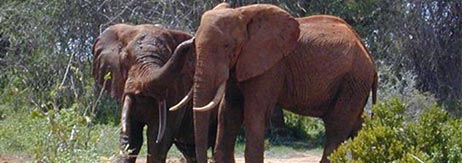Research with Respect for Elephants,
Wildlife and the Habitat
Known Individuals
Tsavo elephant research began in 1989 and is a non-interference research project monitoring the behavior of elephants in Tsavo. The research is based on recognized individuals, many of whom I’ve known for over 15 years. Photographic identifications of distinct features are used to track individuals: Tusks: broken, curved, splayed, one tusk, tuskless; Ears: broken, notches, holes; Tail: twisted, no hair, few hairs, section missing; Trunk: tip-section missing; Body: growths, scars. A database is maintained to monitor all known individuals: updated identification photographs, locations-habitat type, activity, associations, and reproduction: musth cycles, offspring: birth date, sex and survival.
Current Research
Bull Social Dynamics
The current research is focused on individually recognized independent male elephants with an emphasis on older bulls and their behavior related to other elephants and the habitat. This study on bull social dynamics is particularly relevant to elephant conservation because poachers have killed many of the large-old bulls in Tsavo. To protect the few surviving old bulls and those bulls that are getting older requires knowledge of their utilization of the habitat in the bull area and understanding their social behavioral patterns. The results from this study are applicable to management decisions of security, protection of the habitat, fences and supplemental water points.
Research Objectives
Bull Area - Activity
Monitor seasonal resources and ecological conditions of a bull area to determine the attraction of bulls to this specific area. Compare seasonal utilization of the resources in a bull area: habitat: shade for resting; feeding: grass, shrubs, trees, soil; water activity: drinking, mud- wallow and swim.
Bull Associations - Social Network
Compare age and individual bull preferences of social groups and group size: alone with other bulls or with families. Social network: determine pair-wise bonds between bulls and long-term associations.
Bull Group Dynamics - Interactions
Bull-bull Interaction: define behaviors of affiliation: nearest neighbor, greeting, sparring, tactile and dominance behavior: hierarchy, displacement, aggression. Leadership: compare bull group behavioral patterns, lead-follow, wait-for, related to age to determine leadership in bull society.
